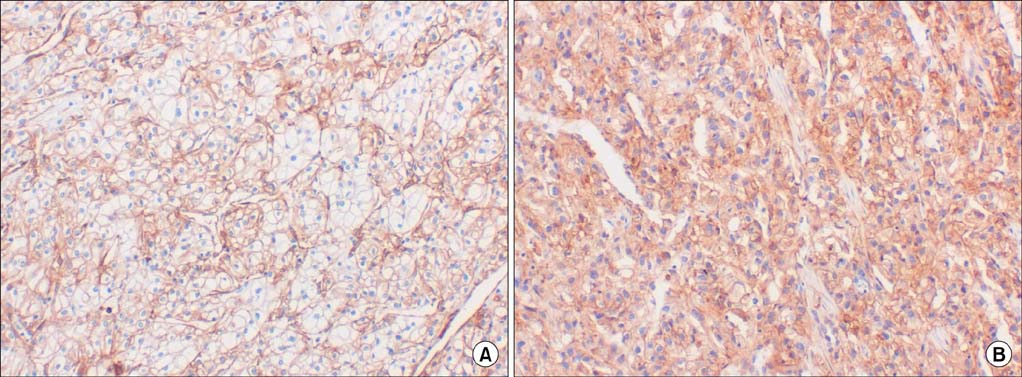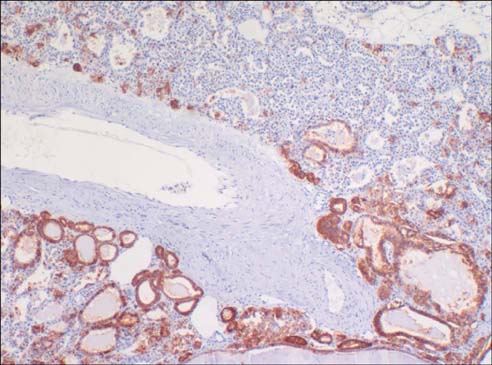Korean J Urol.
2011 Feb;52(2):96-103.
Diagnostic Utility of Caveolin-1 and MOC-31 in Distinguishing Chromophobe Renal Cell Carcinoma from Renal Oncocytoma
- Affiliations
-
- 1Department of Pathology, Samsung Changwon Hospital, Sungkyunkwan University School of Medicine, Changwon, Korea. sudowo@nate.com
- 2Department of Pathology, Pusan National University Hospital, School of Medicine Pusan National University, Busan, Korea.
- 3Department of Pathology, Kosin University College of Medicine, Busan, Korea.
- 4Department of Pathology, Dong-A University College of Medicine, Busan, Korea.
Abstract
- PURPOSE
Renal tumors consist of heterogeneous groups that frequently show complex and overlapping morphology, thus making it difficult to make a correct diagnosis. One of the most problematic differential diagnoses is to distinguish chromophobe renal cell carcinoma (RCC) from oncocytoma. These should be distinguished by differences in their behavior and clinical outcome. Our study was performed to identify whether caveolin-1 and MOC-31 are useful immunohistochemical markers for differentiating chromophobe RCC from oncocytoma.
MATERIALS AND METHODS
We selected 23 chromophobe RCCs, 8 oncocytomas, and 25 clear cell RCCs and performed immunohistochemical staining for caveolin-1 and MOC-31.
RESULTS
Caveolin-1 was positive in 20 (87%) of 23 chromophobe RCCs, 0 of 8 oncocytomas, and 21 (84%) of 25 clear cell RCCs. MOC-31 was positive in 22 (96%) of 23 chromophobe RCCs, 2 (25%) of 8 oncocytomas, and 14 (56%) of 25 clear cell RCCs. There was a statistically significant difference in the expression of caveolin-1 and MOC-31 between chromophobe RCC and oncocytoma (p<0.001). In addition, clear cell RCC was also significantly different from oncocytoma in the expression of caveolin-1 (p<0.001) and was significantly different from chromophobe RCC in the expression of MOC-31 (p<0.001).
CONCLUSIONS
Caveolin-1 and MOC-31 can be useful markers in the differential diagnosis of chromophobe RCC, oncocytoma, and clear cell RCC.
MeSH Terms
Figure
Reference
-
1. Tickoo SK, Amin MB, Zarbo RJ. Colloidal iron staining in renal epithelial neoplasms, including chromophobe renal cell carcinoma: emphasis on technique and patterns of staining. Am J Surg Pathol. 1998. 22:419–424.2. Mazal PR, Exner M, Haitel A, Krieger S, Thomson RB, Aronson PS, et al. Expression of kidney-specific cadherin distinguishes chromophobe renal cell carcinoma from renal oncocytoma. Hum Pathol. 2005. 36:22–28.3. Shen SS, Krishna B, Chirala R, Amato RJ, Truong LD. Kidney-specific cadherin, a specific marker for the distal portion of the nephron and related renal neoplasms. Mod Pathol. 2005. 18:933–940.4. Adley BP, Gupta A, Lin F, Luan C, The BT, Yang XJ. Expression of kidney-specific cadherin in chromophobe renal cell carcinoma and renal oncocytoma. Am J Clin Pathol. 2006. 126:79–85.5. Martignoni G, Pea M, Chilosi M, Brunelli M, Scarpa A, Colato C, et al. Parvalbumin is constantly expressed in chromophobe renal carcinoma. Mod Pathol. 2001. 14:760–767.6. Langner C, Wegscheider BJ, Ratschek M, Schips L, Zigeuner R. Keratin immunohistochemistry in renal cell carcinoma subtypes and renal oncocytomas: a systematic analysis of 233 tumors. Virchows Arch. 2004. 444:127–134.7. Pan CC, Chen PC, Ho DM. The diagnostic utility of MOC31, BerEP4, RCC marker and CD10 in the classification of renal cell carcinoma and renal oncocytoma: an immunohistochemical analysis of 328 cases. Histopathology. 2004. 45:452–459.8. Skinnider BF, Folpe AL, Hennigar RA, Lim SD, Cohen C, Tamboli P, et al. Distribution of cytokeratins and vimentin in adult renal neoplasms and normal renal tissue: potential utility of a cytokeratin antibody panel in the differential diagnosis of renal tumors. Am J Surg Pathol. 2005. 29:747–754.9. Rothberg KG, Heuser JE, Donzell WC, Ying YS, Glenney JR, Anderson RG. Caveolin, a protein component of caveolae membrane coats. Cell. 1992. 68:673–682.10. Liu P, Rudick M, Anderson RG. Multiple functions of caveolin-1. J Biol Chem. 2002. 277:41295–41298.11. Yang G, Truong LD, Timme TL, Ren C, Wheeler TM, Park SH, et al. Elevated expression of caveolin is associated with prostate and breast cancer. Clin Cancer Res. 1998. 4:1873–1880.12. Fine SW, Lisanti MP, Galbiati F, Li M. Elevated expression of caveolin-1 in adenocarcinoma of the colon. Am J Clin Pathol. 2001. 115:719–724.13. Kato K, Hida Y, Miyamoto M, Hashida H, Shinohara T, Itoh T, et al. Overexpression of caveolin-1 in esophageal squamous cell carcinoma correlates with lymph node metastasis and pathologic stage. Cancer. 2002. 94:929–933.14. Fong A, Garcia E, Gwynn L, Lisanti MP, Fazzari MJ, Li M. Expression of caveolin-1 and caveolin-2 in urothelial carcinoma of the urinary bladder correlates with tumor grade and squamous differentiation. Am J Clin Pathol. 2003. 120:93–100.15. Ordóñez NG. Value of the MOC-31 monoclonal antibody in differentiating epithelial pleural mesothelioma from lung adenocarcinoma. Hum Pathol. 1998. 29:166–169.16. Porcell AI, De Young BR, Proca DM, Frankel WL. Immunohistochemical analysis of hepatocellular and adenocarcinoma in the liver: MOC31 compares favorably with other putative markers. Mod Pathol. 2000. 13:773–778.17. Störkel S, Eble JN, Adlakha K, Amin M, Blute ML, Bostwick DG, et al. Classification of renal cell carcinoma: Workgroup No. 1. Union Internationale Contre le Cancer (UICC) and the American Joint Committee on Cancer (AJCC). Cancer. 1997. 80:987–989.18. Ebele JN, Sauter G, Epstein JI, Sesterhenn IA. Pathology and genetics of tumours of the urinary system and male genital organs: World Health Organization classification of tumours. 2004. Lyon: IARC Press;10–43.19. Edge SB, Byrd DR, Compton CC, Fritz AG, Greene FL, Trotti A, et al. AJCC cancer staging manual. 2010. New York: Springer;479–489.20. Thoenes W, Störkel S, Rumpelt HJ. Human chromophobe cell renal carcinoma. Virchows Arch B Cell Pathol Incl Mol Pathol. 1985. 48:207–217.21. Krüger S, Sotlar K, Kausch I, Horny HP. Expression of KIT (CD117) in renal cell carcinoma and renal oncocytoma. Oncology. 2005. 68:269–275.22. Patton KT, Tretiakova MS, Yao JL, Papavero V, Huo L, Adley BP, et al. Expression of RON proto-oncogene in renal oncocytoma and chromophobe renal cell carcinoma. Am J Surg Pathol. 2004. 28:1045–1050.23. Carrion R, Morgan BE, Tannenbaum M, Salup R, Morgan MB. Caveolin expression in adult renal tumors. Urol Oncol. 2003. 21:191–196.24. Mete O, Kilicaslan I, Gulluoglu MG, Uysal V. Can renal oncocytoma be differentiated from its renal mimics? The utility of anti-mitochondrial, caveolin 1, CD63 and cytokeratin 14 antibodies in the differential diagnosis. Virchows Arch. 2005. 447:938–946.25. Garcia E, Li M. Caveolin-1 immunohistochemical analysis in differentiating chromophobe renal cell carcinoma from renal oncocytoma. Am J Clin Pathol. 2006. 125:392–398.
- Full Text Links
- Actions
-
Cited
- CITED
-
- Close
- Share
- Similar articles
-
- A Case of Renal Oncocytoma with Synchronous Contralateral Renal Cell Carcinoma
- Renal Oncocytoma Presenting as a Huge Hypervascular Mass on Ultrasound
- Differentiation of Chromophobe Renal Cell Carcinoma and Clear Cell Renal Cell Carcinoma by Using Helical CT
- Increased Expression of Caveolin-1 in Renal Cell Carcinoma
- Claudin-7 is Highly Expressed in Chromophobe Renal Cell Carcinoma and Renal Oncocytoma






